
Japan
Tokyo, "the capital of the east"

Tokyo, formerly Edo ("River Gate"), became capital of Japan in 1868 with the Meiji Restoration, but it was already prosperous since the Shogun Tokugawa Ieyasu established there the seat of the shogunate in 1603, which marked the period known as Edo (1600-1868). The river running in Tokyo is the Sumida. Since 1853 the Western powers including the United States put pressure on Japan, a country closed on itself, to have it open sea routes. The escalation of this trial of strength causes the U.S. to increase its pressure with the threat of its steam gunboats, leading the shogunate to give in and resign. It is in this context that the restoration of the Emperor (then Emperor Meiji) was established in 1867. The latter had no real power since the 12th century with the accession of a military power (the shogunate). The Meiji era is considered as an age of enlightenment in Japan. Destroyed by bombing during the second World War, Tokyo has become a modern capital, active and looking forward. For a dive in the history of Japan, you have to go to Kyoto ("the capital city") spared during the Second World War (thanks to the intervention of an adviser of the White House). Although located on a seismic zone, to the junction of three tectonic plates ("the ring of fire"), and already affected by a strong earthquake with a magnitude of 7.9 on the Richter scale in 1923, the megalopolis has 30 million inhabitants.
Note that to cope with earthquakes, buildings are built on giant steel springs designed to absorb the seismic waves and avoid collapsing. But beyond a certain magnitude it is likely that the destruction will be unstoppable. Monitoring and warning devices are necessary...
The subway is huge but we manage to find one's way fairly well and even end up by finding it very logical (buying a day ticket is cheaper even though it is not valid on every line). To purchase a single ticket, look at a big panel which indicates the fare regarding to the arrival station. Just one drawback, it is sometimes necessary to walk a lot (in or out) to reach the connections.
About hotels, there is a large choice, but for those who are not claustrophobic, spending a night in a capsule hotel could be original (even if one should not have too many luggage).
Capsule hotels
They are Japanese features which seem to be convenient when you do not have much time to get home. They are a little cheaper than a traditional hotel (to be
competitive) but nevertheless a little expensive (for the profit margin)... Personally, I liked it. There is everything at disposal to spend a night even if we have not
brought sponge bag or a change of clothes as there are shower with shampoo and soap, and we can buy underwear and socks at the reception. They are intended for managers
taken by surprise after a unexpected long evening at the office (and having no means or no train for going back home)...
The capsule (or cab) is the small space where you sleep. It is equipped with a TV (that I didn't watch) and an alarm button in case of need. It is better have earplugs
even though it is incredibly quiet for that kind of place as Japanese discipline is remarkable.
Note that most capsule hotels are not mixed but only for men.
Here is one where I spent a night in Tokyo : Capsule Inn Shimbashi.
The tower of Tokyo
The TV transmitter tower in Tokyo (which dates back to 1958) seems much smaller than the Eiffel Tower in Paris, yet with its 332.6 m (1091 feet) it measures 8.60 m (28 feet) more... It is nice to see it by night and if possible from the viewpoint of Roppongi Hills. Inside, you can walk into a shopping mall. A new TV tower, the "Tokyo Sky Tree", is under construction. It should reach 634 m (2080 feet) in 2012, but for now the tower of Tokyo is still the one that can be seen as a symbol of Tokyo.
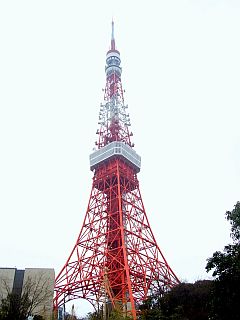
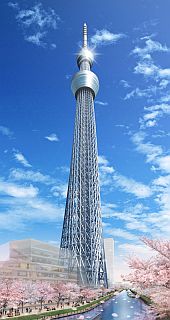
Ueno park
It is the largest park in Tokyo. You can see Shinto shrines (Gojo, and Tosho-gu, under refurbishment during my visit), Buddhist temples (Benten, Kiyo-mizu), pagodas (there was a Buddha near the big pagoda but only its head remains), a pond, the statue of the leaders of the restoration Meiji and museums including the National Museum (see next §) and the National Museum of Science.
National museum
There are various Japanese artifacts but also Chinese and Korean. It can be visited fairly quickly, within an hour (excluding the Asian Collections) unless you want to go into detail. A small portion is devoted to Buddhism but nothing on Shintoism...
Do you know ancient funeral clay figurines called haniwa, the traditional dolls (called Hina or Ningyo), kakemono (a roll made of silk or rice paper containg a painting or a calligraphy and which is vertically hung), woodblock prints, or Japanese weapons...
Senso-ji temple
This is the largest Buddhist temple in Tokyo and the oldest, attended by both wrestlers and kabuki actors (theater). Built in the 7th century, it is dedicated to Kannon (Japanese name of Bodhisattva of Compassion Avalokitesvara) after fishermen on the sumida river found her statue in their nets.
Large lanterns (Chochin) hung on the two main doors were offered by the union of geishas. We access to the temple via a shopping street. You can buy a Daruma. In Buddhist/Shinto syncretism, there is a wishing figurine called Daruma (named and represented from the monk Daruma founder of the sect Chan in China, called Zen in Japan. We paint an eye when we realize a wish (it should also be written on a paper) then a second eye is painted when the wish comes true (and we should write how he has come true). If the wish has not been fulfilled, we may send the Daruma back to the Temple (where it had been purchased) for have it burned, which indicates to the kami (Shinto spirit) that we have not renounced our vow, but we have chosen another way to have it fulfilled.
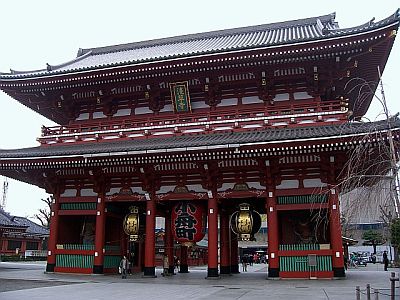
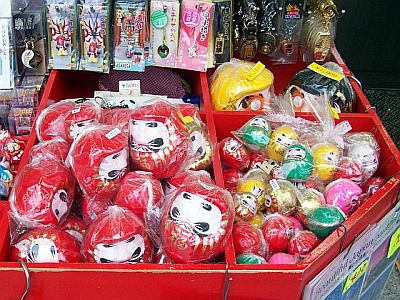
In the temple, in front of the incense burner, you may notice people trying to bring the vapors of incense on them. It is a "ritual" to heal physical harm.
Meiji shrine
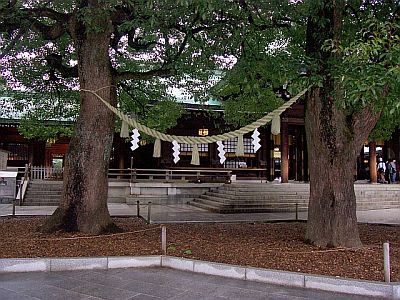
It is the largest Shinto shrine in Tokyo. With a little luck you would be able to see a wedding.
The torii marks the entrance to the sanctuary. In Shintoism, places of worship are sanctuaries or jinja and their entrance is marked by a torii which name means "bird perch". Cocks were put there to have their singing accompany the rising of the sun, goddess Amaterasu, to whom the cocks were then sacrificed.
We can also see stacks of cans of sake which were offered to the kami by companies or individuals
The sacred rope (shimenawa) made with plaited rice straw and on which is hung shides (strips of paper folded in zigzag) is used to delimit the sacred territory of the kami. The shides represent the kami. It is usually tightened between trees.
Imperial gardens
The Imperial Palace is not open, Emperor Akihito (the son of last Emperor Hirohito) still lives there... However, some of the (large) gardens are open to visitors. Arguably a nice stroll in April when trees are in bloom, but in March under the rain it is definitely not the same...
There is the statue of samurai Kusunoki Masahige. Military commander of the 14th century, he led a fight to the death alongside Emperor Go-Daigo in his attempt to regain power from the shogunate (military leaders) of Kamakura. Since the Meiji Restoration, he was honored for his devotion and loyalty to the Emperor. In the garden we can visit a small museum of the Imperial Collections (gifts of Heads of State to the Emperor and Empress). We can also see several species of trees.
Districts
We can visit the rest of Tokyo by district. Here are the main districts (in an arbitrary order).
Shibuya

Shibuya is a bustling modern area with numerous shops. There is a very big crossroads where the crowd emerges from anywhere without running into each other... quite impressive under the rain with all those umbrellas...
Hachiko (from hachi "eight" because he was the eighth puppy of a litter and "ko" which is a suffix used for affection) is a dog akita (Japanese breed) who
came and wait for his master near the station for more than 10 years after his death... (It is the same story as greyfriars bobby in Edimbourg in Scotland).
A statue is put on Shibuya square and it is used as a meeting point.
There is another meeting point near a "moyai" statue (given to Shibuya in 1980 by Niijima islanders, inhabitants of an island in the Pacific in the south of
Tokyo). And of course, the neon lights are flashing at night...
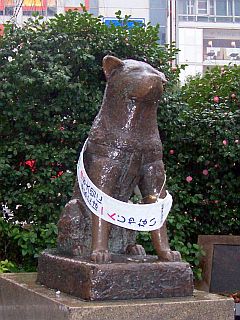
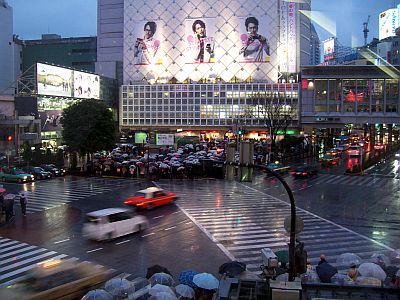
Ginza
This is the smart district with many fashion brands (Chanel, Dior, Hermes...) buildings. There is also the Sony tower, with a showroom opened until 7p.m. At night, the neon lights are dazzling...
Roppongi
Roppongi Hills is an interesting place for a night out with plenty of shops (many clothing stores), restaurants including a
French Joël Robuchon restaurant (note also that there is also a restaurant "Paul Bocuse" near Tokyo Station), a great cinema (with sometimes V.O. American movies),
and a nice view of Tokyo Tower or yet better over the whole city (of an incredible expanse) from a high panoramic tower (the Mori tower).
The big metal spider sculpture is the work of Franco-American artist Louise Bourgeois (1911-2010). Her works, surrealistic, were based on the reactivation
of childhood memories and she identified this work with her mother who worked in the restoration of tapestry, like a spider spins its web... We can found
reproductions of this work in several major cities around the world, like here in Tokyo but also Ottawa... Another example of a reproduction of a work of an artist that
can be found in several towns in the world is "the man with the hammer" by Jonathan Borofsky
(Seoul, Francfurt...).
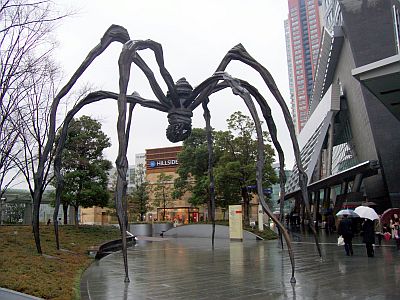
For the evening, there is a good sushi restaurant on the first floor downstairs : sushi or maki-sushi can be picked up on a conveyor belt. We take as many as we want and we pay the number of plates according to their colors (each color corresponds to a base fare).
Nearby, there is the TV Asahi headquarters, with a manga figurine at the entrance : the robot cat Doraemon.
Omotesando and Harajuku
You must go to Harajuku (near Meiji Shrine) during a weekend to have a look at cosplays (costume players), these teenagers who gather together by wearing costumes of characters from manga or imaginary heroes. Too bad for me, it was raining hard and I could not see them, except for a "little red riding hood" (probably another character in Japan)... We can also catch sight of them in the Akihabara electronics district (the same for me, it was raining melted snow... but I've met a couple in fancy dress costume in a video games complex).
At Omotesando, there is a wide avenue, but there is not much to see except a museum of ukiyo-e (Japanese woodblock prints).
The best known creators of ukiyo-e are Hokusai "Old man mad at paintings" as he nicknamed himself at 75 (1760-1849) and Hiroshige (1797-1858). Hokusai who carried out 36 views of Mount Fuji (the most famous is "the great wave") influenced Western impressionist artists such as Van Gogh, Matisse... He even influenced Hergé : one vignette of the album "Cigars of the Pharaoh" where Tintin is going to be swamped by a wave is a veiled message to "the great wave" from Hokusai. Hokusai is sometimes considered as the father of manga ("quick sketch"). Hiroshige carried out a set of 100 famous places of Edo (old name of Tokyo). He has also influenced impressionist artists (such as Van Gogh or Monet).
Below, the famous woodblock print from Hosukaï (whose prints are sometimes... weird) and a print from Hiroshige that influenced Van Gogh.
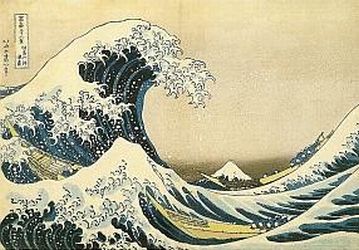
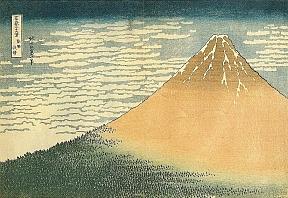
The ukiyo-e requires the coordination of work of a designer, a engraver and a printer.
Ryogoku : Edo-Tokyo museum
This would be a pitty not to go to the Edo-Tokyo Museum, very interesting and a good complement to the National Museum (I even found it more interesting than the latter).
We can learn about the history of Tokyo, but not only, we also learn a lot about Japanese customs. For instance one can see kimonos, traditional clothing worn for special occasions (the belt, obi, is tied in the back), armors and weapons of samurai (more info on page Himeji), or a statue of Tokugawa Ieyasu, first shogun of the Edo period, holding a fan.
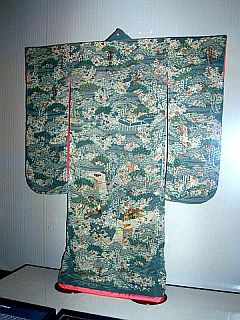
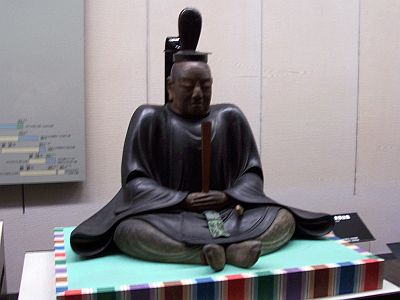
The shogun held a gunsen, lacquered wooden fan, which they used to order the troops : open, it could serve as a signal and closed it could serve as a protection. Tessens are other war fans made in iron (the tessenjutsu is a martial art -not commonly practiced today- based on the use of tessen to counter throw of weapons). The samurai could hold a war fan, particularly when going to places where "classic" weapons had to be left outside.
The shogun, commander in chief, was the ruler of the country, before the emperor, since the 12th century. With the shogun Tokugawa Ieyasu, Edo became the "headquarters" of the shogunate in 1603 whereas Kyoto remained the imperial capital (see also Nikko). The shogunate was abolished in 1868 and Edo became both Tokyo and the new imperial capital...
Japanese prints (ukiyo-e) are made on wood by applying the colors one by one with matrixes. So three crafts are necessary : designing, engraving, and printing. See also rickshaws, mikoshi (portative shrine) and processions...
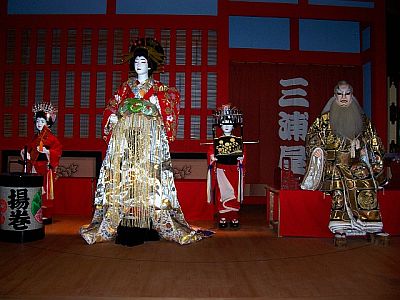
And there are reproductions of scenes from kabuki with dummies. The kabuki has been listed as Unesco heritage since 2008 (as intangible heritage). Here is a link to an Unesco video about kabuki.
Kabuki appeared in the 17th century as a popular theater. It is a spoken drama whereas noh is a sung drama.
At the beginning, there were
several cases of actresses who prostituted themselves with spectators which brings the Shogun to forbid women and actresses who were then replaced by young men but
they were also forbidden (for the same reasons) and were in turn replaced by older men.
There are still men who hold the role of
women although there are also women who reappear to take their role but they do not get the same success with the public. The actors who hold
female roles are called onnagata (or Oyama) and some have a great reputation (as a "star" of cinema in the West) such as Tamasaburo.
The makeup used by the actors
is called kesho and is made with rice powder. Colors are added to the white base : red for a hero, purple for a noble character, blue for a negative character,
and green for a supernatural being. Note that in the noh, the actors wear masks instead of makeup (yet another difference).
Ryogoku : sumo museum
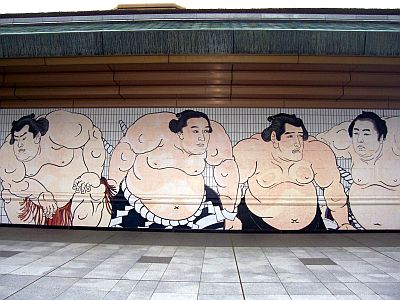
In this district, there is also the sumo stadium with a small (very small) museum. Sumo, a Japanese wrestling sport from Shinto origin, has been the sport the most popular in Japan for long but it is now overtaken by baseball (Japan is one of the greatest nations of baseball) and soccer. Wrestling are hold only every two months for two weeks. The wrestlers are called rikishi.
The dohyo is the square compacted clay platform on which take place sumo wrestling. At the beginning of the battle, the two rikishi face each other in a sacred circle of 4.55 m (5 yards) diameter materialized by bales of rice straw embedded in the platform. The one whose part of the body except the feet touch the ground loses the fight. He also loses if a part of his body (and not the whole body) goes outside the circle. The atari is the first contact of rikishi who rushed upon each other at the beginning of the combat (nothing to do with the brand of computer atari from the 80's who was American and is now French via infogrames). Rikishi do their hair in the shape of a knot according to their rank. They can wear only one garment : the mawashi, called shimekomi if made of silk (for the two first divisions of wrestler). The strings attached to the mawashi (or shimekomi) are purely ornamental and can sometimes break off during the match. Before the bout begins, the two rikishi launch salt in the air to purify the dohyo.
Shinjuku, skyscrapers side
Shinjuku is the largest district of Tokyo. This district is comprised of two large parts. The one with pachinkos, cinemas, and also love hotels... and the other completely different with numerous skyscrapers and office blocks. Below, the city hall (243 m or 797 feet high with a free panoramic platform on the 45th floor) and the cocoon tower (just over 200 m or 656 feet high).
Near this area there is a small sword museum (not that easy to find, so you'd better have a map). There is often only the blade with sometimes the hilt (decorated) but we learn all about the art of manufacturing nipponto (very good explanations and leaflet in English). The name katana is given by abuse of language to Japanese swords. The katana is in fact a type of blade. To be rigorous, we should say nipponto in the general case. What makes nipponto different is its sharp blade both sharp and resilient (the forging technique used makes it resistant to shocks). Although it appeared between the 4th and 9th century, it is in the middle of the 10th century that it had been perfected. The steel used is tamahagane, produced with very few impurities. It is folded several times and then forged until creating a blade into two parts : the inner core, ductile, and the outer, hard. After polishing, a pattern is created on its blade. Several craftmen are involved in the manufacture of a nipponto. Then there are, as with any sword, precautions to take in order to keep it sharp and prevent rust.
Akihabara
It is the largest district of electronics, video games and manga that can be translated as "quick sketch" and which is the name of Japanese comics, sometimes given by extension to cartoons which are inspired by them. The kind of manga featuring humanoid robots or characters monitoring robots (Mazinger Z, Grendizer...) is called mecha.
It is nice by night with the dazzling neons...
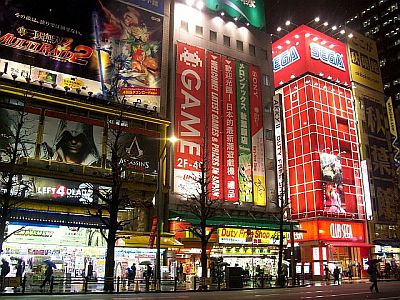
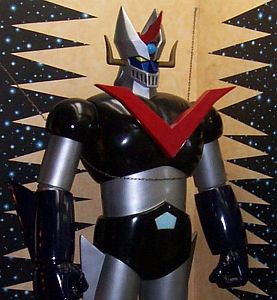
Below the front of a pachinko. You buy the beads that are introduced in a kind of vertical pinball. The goal is to get more balls. We can then exchange these balls for books or CDs because gambling is forbidden in Japan. However... you can then sell those books or CDs to another store next the pachinko. Not speaking Japanese, and because of lack of time, I have not experienced it... There are also gachapon which are vending machine of collectible figurines, often related to manga.
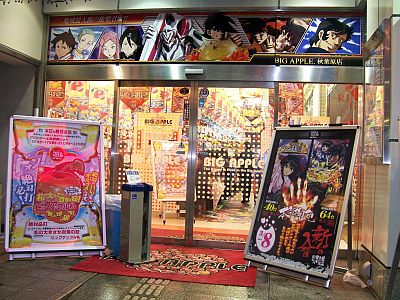
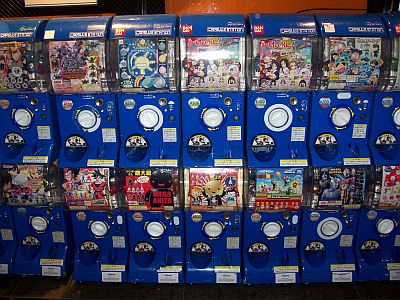
Odaiba
This district is located on a large artificial island and is comparable to no other district of Tokyo.
The rainbow bridge, the Liberty statue replica, and the headquarters of Fuji TV (we can get to a panaromic platform at daytime) are the main curiosities. There are also a shopping mall with cinemas.
Others
-
The fishmarket of Tsukiji is the largest fishmarket in the world. We must get there early in the morning (at 9 a.m everything is over).
-
The international forum. The metal frames of the roof look like the hull of a ship, don't they ?
-
The upside down "golden flame" on the top of the Asahi brewery headquarters building is original : it represents the spirit of conquest of the brewery (though we do not necessarily recognize a flame at first sight... As far as I am concerned I thought it was a meteorite, and other people have other opinions...). However it can not be missed when exiting the subway station "Asakusa" (before taking the road to the temple Senso-ji for instance) as it measures 40 m or 131 feet high.
-
Mount Takao near Tokyo is the opportunity to hike in the mountain and it is also a place where Tengus would live. Tengu are kami with either a crow's beak or a long nose. I unfortunately could not go there because of too much rain...
-
And still a lot more...
